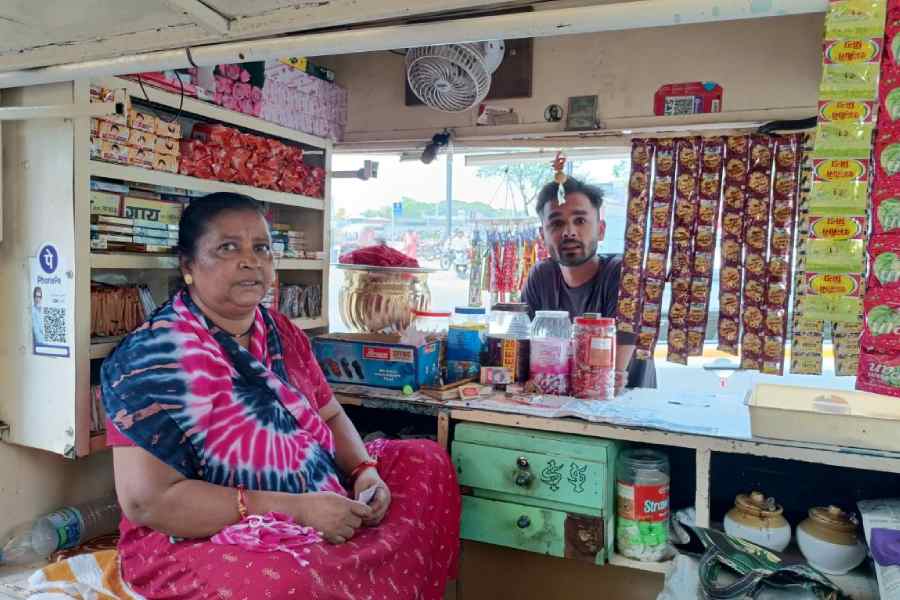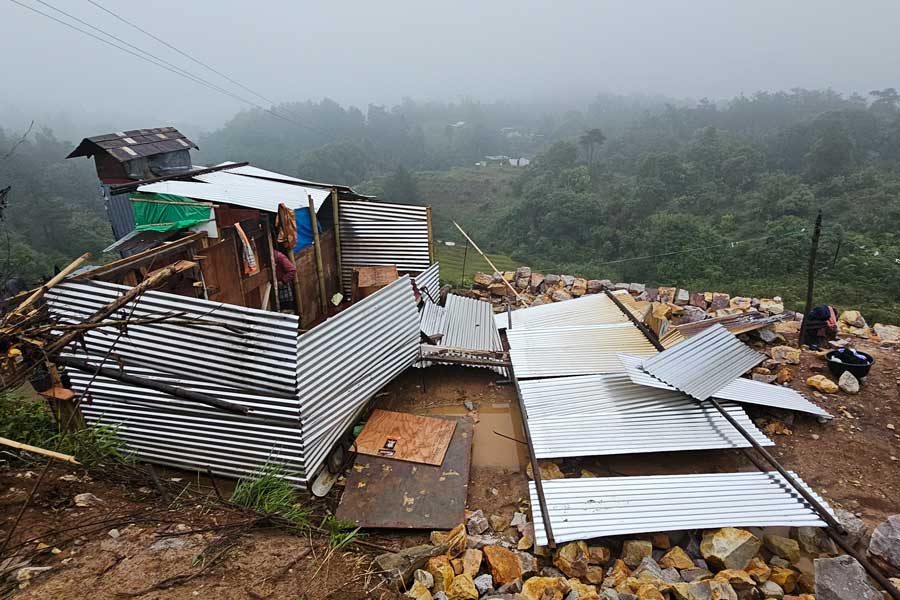There are roughly 1,000 plus bajars or markets in Calcutta. Of these, 52 come under the Calcutta Municipal Corporation and the rest are privately owned and unregistered markets, dealing in fish, meat, fruits and vegetables. There is the Baithakkhana Bajar which is Calcutta’s largest wholesale market for groceries. There is Koley Market famed for fish and vegetables. There is Mechua Bazar known for its fruits. Some other markets are famous by association. Someone will say, “Uttam Kumar shopped at Jadubabur Bajar,” someone else will say, “No, Ranjit Mullick did,” things like that.
In the essay Calcutta’s Markets, Raghab Bandopadhyay writes,“...the biggest markets — Hatibagan, Sealdah, Maniktala, Gariahat, Lake Market — have two sectors, an inner and an outer. The inner is the official or core market in a planned building; the outer, a spattering of pavement stalls and humble displays very like the village haat…”
Every afternoon, Chaitali Haldar, who lives in the Khorki colony in south Calcutta, stops in front of the vendors lining the pavement outside Mukundapur Market. She buys vegetables and fish from here. Slightly wilting green leafy vegetables sell at Rs 3 a bundle, medium-sized brinjals come at Rs 10 a kilogram, bitter gourds at Rs 10 a kilogram and so on. Sarit Chakraborty, a retired government officer, shops in the mornings, between 7am and 9am, at Mukundapur Market. He crosses the market that Chaitali shops from and enters the main market. Here, medium-sized brinjals cost Rs 100 per kilogram, and bitter gourds Rs 80 a kilo and the shaak costs Rs 20 a bundle.
Chaitali is aware of the market where Sarit shops, but it is unlikely that her daily haunt is even visible to Sarit and his ilk.
Invisible Market 1
Located in a lane outside Baithakkhana Bajar on Bowbazar Street
- Visible market peak hour: This is between 6am and 11am
- Invisible market timings: 10am-3pm
- Price of 1kg of onion at visible market: Rs 15-20
- Price of 1kg onion at invisible market: Rs 7-10
The Sealdah Station was built in 1869; the Baithakkhana Bajar came after. The scene here is unchanging. Small and big pick-up trucks parked on either side of the road leading to the market and vans loaded with vegetables. Vendors line the pavements. Some familiar sights: a woman peeling away the darkened layers of onions till the pink emerges, a man working on a bunch of grapes. “I am operating,” he jokes. A customer appears. The man says, “They are very sweet, that is why they have gone black.” The customer, a daily wager, asks for 250 grams and pays Rs 10. At Baithakkhana Bajar these would cost Rs 25. Robin Mondal, who has a vegetable shop in the main market, tells The Telegraph how men and women hang around trucks loaded with fresh produce and rush and squabble over the spilled onions, potatoes, ladies fingers and litchis. The spillage finds its way into the kuraya market — the local name for the invisible market. This market also gets its supply from “sorting”. Robin says, “Wholesalers sort lemons, gooseberries, even onions as per their size and freshness. What is rejected is taken away by the street-side vendors.” Broken eggs sell here at Rs 5 for three. Women collect varieties of shaak or leafy greens growing near the canals or ponds, or by the roadside and sell them here. A little ahead, a vendor is selling fish scales, fish heads and fish eggs. Local varieties of small fish are spread out on plastic sheets, not very fresh though from the looks of it. A kilo of tangra sells at Rs 150; in the main market, a more robust version would sell for no less than Rs 400. The clientele comes from the slums of the adjoining Sealdah-Park Circus area, Rajabazar and Entally, pavement-dwellers of Surya Sen Street and Bowbazar Street and daily wagers. The main market is the haunt of retailers who will finally sell it to markets close to highrises and housing societies. By the time the produce reaches those markets, the prices would have gone up by 50 per cent.
Invisible Market 2
Ballygunge Station Road Market, located beneath Bijon Setu, which is a stone’s throw from Gariahat Market
- Visible market peak hour: 6am-11am
- Invisible market timings: 10am-3pm
- Price of 1kg bhetki at visible market: Rs 700
- Bhetki is not available at the invisible market
The Gariahat Market came up in the late 19th century. Over the years it has become one of the biggest markets of south Calcutta. The nearest railway station is Ballygunge. Trains come from Budge Budge, Diamond Harbour and Canning carrying men and women who work as domestic help, ayahs, nurses, daily wagers. The invisible market is located on the road leading out of the station and also up to it. There are vendors selling blackened guavas, dried mango pulp (usually consumed as a snack with puffed rice or rice) and aamshotto or aam papad at Rs 80 a kilo. At the main market, there are different varieties of aamshotto selling at Rs 300, Rs 400 and Rs 600. Familiar sight, a woman chopping mocha or plantain flower. “Many people do not have time to do this,” she says. What remains unsaid is that the version of the vegetable she is selling is mostly withered and in its entirety would not attract customers.
Invisible Market 3
Located on railway platforms. Almost every station from Ballygunge to Sonarpur on the Lakshmikanta- pur/Canning/Diamond Harbour line has “platform markets”
- Market timings: 12 noon to 4pm
- Price of 1kg litchis: Rs 20. The same costs Rs 80-100 in main markets
The station market is the only market that the labourers and domestic helps can access when they are going back home. Around 3pm, a 20-something woman is hurrying past with a bag full of bananas and packets of chips. She says, “I got two dozen bananas for Rs 10. They are in good shape, only over-ripe; they have to be consumed tonight.” The chips are from Dibakar Parami’s shop. He stocks broken biscuits, packets of potato chips, instant noodles, cornflakes and tea cakes whose expiry dates have long passed. Panchanan Naskar sells spices at the Dhakuria railway station. He has them laid out in small square-shaped pieces of paper. Each square has a 10-gram heap of red chilli, coriander, cumin, turmeric and sells for Rs 2-5. What is the catch here? “No catch,” he says. “Sometimes, the shopkeepers cannot sell packets that have a tear in them. The packets get torn during packing. The spices mix.” Panchanan also collects sacks of pulses — masoor, moong, arhar, chana, black moong all mixed up. He sells these at Rs 10 a kilo. He also sells rice, once again a mix of parboiled and sunned varieties. He says, “I get my supply from Burrabazar, where they keep this rice aside for beggars. Poor priests also sell their day’s collections.”










